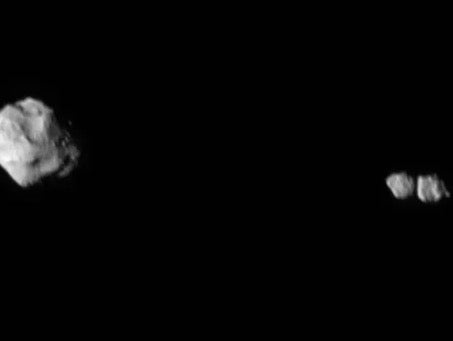
NASA’s Lucy mission is seeing double. NASA announced Nov. 2 the spacecraft found that its first target, Dinkinesh, is orbited by a smaller satellite. If that wasn’t enough, recent data found the satellite is actually two objects in permanent contact with one another, known as a contact binary.
“We’d been puzzling over odd variations in Dinkinesh’s brightness that we saw on approach, which gave us a hint that Dinkinesh might have a moon of some sort, but we never suspected anything so bizarre!” said John Spencer, Lucy deputy project scientist, in a NASA news release.
The Lucy Long-Range Reconnaissance Imager (L’LORRI) took this picture of the objects on Nov. 6, six minutes after the mission’s closest approach and approximately 1,010 miles (1,630 km) away. Initial images of the Dinkinesh system, which revealed the moon, did not catch the contact binary because one lobe sat directly behind the other from that point of view.
Although researchers said in the NASA release that such two-lobed asteroids are common in the solar system, we have had few opportunities to get pictures of them. One such opportunity was New Horizons’ pass of the Kuiper belt object Arrokoth (previously known as Ultima Thule), which also turned out to be a contact binary.
“I would have never expected a system that looks like this. In particular, I don’t understand why the two components of the satellite have similar sizes. This is going to be fun for the scientific community to figure out,” said Lucy principal investigator Hal Levison.
Lucy found that Dinkinesh itself comes in at about 0.5 mile (790 meters) at its widest, while the smaller pair measures 0.15 mile (220 m) across.
The Lucy team chose the target in early 2023 as a method of checking the mission’s tracking and imaging systems and will continue to download data from the encounter.
Lucy’s next objective involves heading toward Earth for a gravity assist in December of next year. The craft will then take images of DonaldJohanson, which is five times the size of Dinkinesh, on April 20, 2025. Then Lucy will begin its primary mission to study Jupiter’s Trojan asteroids in 2027.









